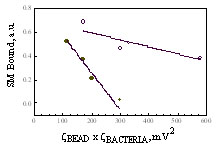ABSTRACT: 3429
Green Tea Electrostatic Inhibition of S. mutans Binding to Hydroxyapatite
| K. POLOSUKHINA, S. HIGHSMITH, and A. PETERSEN, Pacific, San Francisco, CA, USA | |
Green tea inhibits the binding of bacteria to enamel. We think electrical interactions may be involved making the zeta potential, ζ, a relevant electrical property to measure. We have investigated the effects of oolong tea extract (OTE) on ζ for SM (S. mutans), HA (hydroxyapatite) and saliva-coated HA (salHA) and on the binding of SM to HA and to salHA. Objective: To correlate changes in SM binding to HA and salHA with OTE-induced changes in ζ for each species. Methods: SM, HA (20 μm diameter beads), and salHA are incubated independently with OTE and then washed. Electrophoretic mobilities, μe, are measured by phase analysis light scattering, and values of ζ are calculated from μe using the Smoluchowski equation. Relative binding strengths are determined by measuring the free [SM] after removing the bound by sedimentation. Results: OTE increases the magnitude of -ζ for SM, and salHA and decreases the magnitude of -ζ for HA. The product of ζBEAD x ζBACTERIA has a linear negative inverse correlation with binding, with different slopes for HA and salHA. Conclusions: Increased non-specific electrostatic repulsion from increased -ζ is a major mechanism by which green tea inhibits SM binding. The different slopes and intercepts for the ζBEAD x ζBACTERIA dependences of binding are likely due to specific electrical and non-electrical contributions to binding in the absence and presence of saliva.
| |
| Seq #310 - Streptococci B 1:45 PM-3:00 PM, Saturday, July 5, 2008 Metro Toronto Convention Centre Exhibit Hall D-E | |
|
Back to the Microbiology / Immunology and Infection Control Program | |
©Copyright 2008 American Association for Dental Research. All Rights Reserved.
